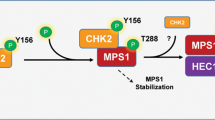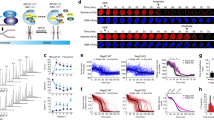Abstract
Mitotic spindle assembly is a highly regulated process, crucial to ensure the correct segregation of duplicated chromosomes in daughter cells and to avoid aneuploidy, a common feature of tumors. Among the most important spindle regulators is Aurora-A, a mitotic centrosomal kinase frequently overexpressed in tumors. Here, we investigated the role of Aurora-A in spindle pole organization in human cells. We show that RNA interference-mediated Aurora-A inactivation causes pericentriolar material fragmentation in prometaphase, yielding the formation of spindles with supernumerary poles. This fragmentation does not necessarily involve centrioles and requires microtubules (MTs). Aurora-A-depleted prometaphases mislocalize the MT-stabilizing protein colonic hepatic tumor-overexpressed gene (ch-TOG), which abnormally accumulates at spindle poles, as well as the mitotic centromere-associated kinesin (MCAK), the major functional antagonist of ch-TOG, which delocalizes from poles. ch-TOG is required for extrapole formation in prometaphases lacking Aurora-A, because co-depletion of Aurora-A and ch-TOG mitigates the fragmented pole phenotype. These results indicate a novel function of Aurora-A, the regulation of ch-TOG and MCAK localization, and highlight a common pathway involving the three factors in control of spindle pole integrity.
This is a preview of subscription content, access via your institution
Access options
Subscribe to this journal
Receive 50 print issues and online access
$259.00 per year
only $5.18 per issue
Buy this article
- Purchase on Springer Link
- Instant access to full article PDF
Prices may be subject to local taxes which are calculated during checkout







Similar content being viewed by others

References
Agnese V, Bazan V, Fiorentino FP, Fanale D, Badalamenti G, Colucci G et al. (2007). The role of Aurora-A inhibitors in cancer therapy. Ann Oncol 6: vi47–vi52.
Anand S, Penrhyn-Lowe S, Venkitaraman AR . (2003). AURORA-A amplification overrides the mitotic spindle assembly checkpoint, inducing resistance to Taxol. Cancer Cell 3: 51–62.
Andrews PD . (2005). Aurora kinases: shining lights on the therapeutic horizon? Oncogene 24: 5005–5015.
Barr AR, Gergely F . (2007). Aurora-A: the maker and breaker of spindle poles. J Cell Sci 120: 2987–2996.
Barros TP, Kinoshita K, Himan AA, Raff JW . (2005). Aurora-A activates D-TACC-Msps complexes exclusively at centrosomes to stabilize centrosomal microtubules. J Cell Biol 170: 1039–1046.
Blagden SP, Glover DM . (2003). Polar expeditions-provisioning the centrosome for mitosis. Nature Cell Biol 5: 505–511.
Cassimeris L, Morabito J . (2004). TOGp, the human homolog of XMAP215/Dis1, is required for centrosome integrity, spindle pole organisation, and bipolar spindle assembly. Mol Biol Cell 15: 1580–1590.
Ciciarello M, Mangiacasale R, Lavia P . (2007). Spatial control of mitosis by the GTPase Ran. Cell Mol Life Sci 64: 1891–1914.
De Luca M, Lavia P, Guarguaglini G . (2006). A functional interplay between Aurora-A, Plk1 and TPX2 at spindle poles: Plk1 controls centrosomal localization of Aurora-A and TPX2 spindle association. Cell Cycle 5: 296–303.
Doxsey S . (2001). Re-evaluating centrosome function. Nature 2: 688–698.
Fielding AB, Dobreva I, McDonald PC, Foster LJ, Dedhar S . (2008). Integrin-linked kinase localizes to the centrosome and regulates mitotic spindle organization. J Cell Biol 180: 681–689.
Fukasawa K . (2006). Centrosome amplification, chromosome instability and cancer development. Cancer Lett 230: 6–19.
Gadde S, Heald R . (2004). Mechanism and molecules of the mitotic spindle. Curr Biol 14: 797–805.
Gard DL, Becker BE, Romney JS . (2004). MAPping the eukaryotic tree of life: structure, function, and evolution of the MAP215/Dis1 family of microtubule-associated proteins. Int Rev Cytol 239: 179–272.
Gergely F, Draviam VM, Raff JW . (2003). The ch-TOG/XMAP215 protein is essential for spindle pole organization in human somatic cells. Genes Dev 17: 336–341.
Giet R, McLean D, Descamps S, Lee MJ, Raff JW, Prigent C et al. (2002). Drosophila Aurora A kinase is required to localize D-TACC to centrosomes and to regulate astral microtubules. J Cell Biol 156: 437–451.
Giet R, Petretti C, Prigent C . (2005). Aurora kinases, aneuploidy and cancer, a coincidence or a real link? Trends Cell Biol 15: 241–250.
Hoar K, Chakravarty A, Rabino C, Wysong D, Bowman D, Roy N et al. (2007). MLN8054, a small-molecule inhibitor of Aurora A, causes spindle pole and chromosome congression defects leading to aneuploidy. Mol Cell Biol 27: 4513–4525.
Holmfeldt P, Zhang X, Stenmark S, Walczak CE, Gullberg M . (2005). CaMKIIgamma-mediated inactivation of the Kin I kinesin MCAK is essential for bipolar spindle formation. EMBO J 24: 1256–1266.
Kinoshita K, Noetzel TL, Pelletier L, Mechtler K, Drechsel DN, Schwager A et al. (2005). Aurora A phosphorylation of TACC3/maskin is required for centrosome dependent microtubule assembly in mitosis. J Cell Biol 170: 1047–1055.
Koffa MD, Casanova CM, Santarella R, Köcher T, Wilm M, Mattaj IW . (2006). HURP is part of a Ran-dependent complex involved in spindle formation. Curr Biol 16: 743–754.
Kops GJ, Weaver BAA, Cleveland DW . (2005). On the road to cancer: aneuploidy and the mitotic checkpoint. Nature Rev Cancer 5: 773–785.
Kufer TA, Sillje HH, Korner R, Gruss OJ, Meraldi P, Nigg EA . (2002). Human TPX2 is required for targeting Aurora-A kinase to the spindle. J Cell Biol 158: 617–623.
Lee MJ, Gergely F, Jeffers K, Peak-Chew SY, Raff JW . (2001). Msps/XMAP215 interacts with the centrosomal protein D-TACC to regulate microtubule behaviour. Nat Cell Biol 3: 643–649.
LeRoy PJ, Hunter JJ, Hoar KM, Burke KE, Shinde V, Ruan J et al. (2007). Localization of human TACC3 to mitotic spindles is mediated by phosphorylation on Ser558 by Aurora-A: a novel pharmacodynamic method for measuring Aurora A activity. Cancer Res 67: 5362–5370.
Luders J, Stearns T . (2007). Microtubule-organizing centres: a re-evaluation. Nat Rev Mol Cell Biol 8: 161–167.
Manning AL, Compton DA . (2007). Mechanisms of spindle-pole organization are influenced by kinetochore activity in mammalian cells. Curr Biol 17: 260–265.
Marumoto T, Honda S, Hara T, Nitta M, Hirota T, Kohmura E et al. (2003). Aurora-A kinase maintains the fidelity of early and late mitotic evens in HeLa cells. J Biol Chem 278: 51786–51795.
Marumoto T, Zhang D, Saya H . (2005). Aurora-A—a guardian of poles. Mol Cell Biol 5: 42–50.
Meraldi P, Honda R, Nigg EA . (2002). Aurora-A overexpression reveals tetraploidization as a major route to centrosome amplification in p53−/− cells. EMBO J 21: 483–492.
Nigg EA . (2006). Origins and consequences of centrosome aberrations in human cancers. Int J Cancer 119: 2717–2723.
Peset I, Seiler J, Sardon T, Bejarano LA, Rybina S, Vernos I . (2005). Function and regulation of Maskin, a TACC family protein, in microtubule growth during mitosis. J Cell Biol 170: 1057–1066.
Sharp DJ, Rogers GC, Scholey JM . (2000). Microtubule motors in mitosis. Nature 407: 41–47.
Weaver BA, Cleveland DW . (2005). Decoding the links between mitosis, cancer, and chemotherapy: the mitotic checkpoint, adaptation, and cell death. Cancer Cell 8: 7–12.
Weaver BA, Cleveland DW . (2006). Does aneuploidy cause cancer? Curr Opin Cell Biol 18: 658–667.
Zhang X, Ems-McClung SC, Walczak CE . (2008). Aurora A phosphorylates MCAK to control Ran-dependent spindle bipolarity. Mol Biol Cell 19: 2752–2765.
Acknowledgements
We thank M Ciciarello and R Mangiacasale for helpful discussions and JL Salisbury and C Walczak for reagents. This work was supported by AIRC (Italian Association for Cancer Research) grants (to PL).
Author information
Authors and Affiliations
Corresponding author
Additional information
Supplementary Information accompanies the paper on the Oncogene website (http://www.nature.com/onc)
Supplementary information
Rights and permissions
About this article
Cite this article
De Luca, M., Brunetto, L., Asteriti, I. et al. Aurora-A and ch-TOG act in a common pathway in control of spindle pole integrity. Oncogene 27, 6539–6549 (2008). https://doi.org/10.1038/onc.2008.252
Received:
Revised:
Accepted:
Published:
Issue Date:
DOI: https://doi.org/10.1038/onc.2008.252
Keywords
This article is cited by
-
Male meiotic spindle poles are stabilized by TACC3 and cKAP5/chTOG differently from female meiotic or somatic mitotic spindles in mice
Scientific Reports (2024)
-
Identification and characterization of deschloro-chlorothricin obtained from a large natural product library targeting aurora A kinase in multiple myeloma
Investigational New Drugs (2021)
-
The functional diversity of Aurora kinases: a comprehensive review
Cell Division (2018)
-
A FRET biosensor reveals spatiotemporal activation and functions of aurora kinase A in living cells
Nature Communications (2016)
-
Mitotic spindle multipolarity without centrosome amplification
Nature Cell Biology (2014)


